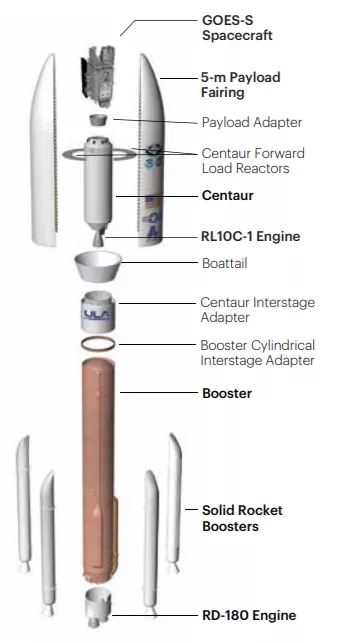
NOAA's GOES-S will travel to space aboard a ULA Atlas V 541 expendable launch vehicle, or rocket. The “541” refers to the configuration of the rocket: payload fairing, or nose cone, that covers the satellite is approximately 5 meters in diameter; the four solid rocket boosters that generate extra thrust off the launch pad; and a single engine on the Centaur upper stage. Fully fueled, GOES-S’s Atlas V 541 rocket weighs more than 1 million pounds and is approximately 197 feet tall.
GOES-S and its Atlas V rocket will begin its journey to space when the booster engine and solid rocket boosters ignite and the rocket blasts off. Just under 2 minutes after leaving the launch pad, the rocket’s four solid rocket boosters will complete their burns and be jettisoned while the Atlas booster continues to burn. Approximately 90 seconds later, the payload fairing halves separate and fall back, no longer needed after leaving Earth’s atmosphere. About a minute later, the booster engine will shut down, known as booster engine cutoff (BECO), and the booster and Centaur upper stage separate. With the upper stage now flying free, the main engine will start its first burn. This burn will last for nearly eight minutes before the first main engine cutoff (MECO-1).
After a total of three burns of the Centaur upper stage engine, GOES-S will separate from the upper stage and fly alone in space for the first time! This will occur roughly three and a half hours after liftoff. In the days that follow, GOES-S will perform several instrument deployments and a series of maneuvers to bring the satellite into geostationary orbit. This is scheduled to occur 17 days after launch. Once GOES-S, now GOES-17, is placed in geostationary orbit, it will undergo a period of checkout and validation, moving to the GOES West operational position in late 2018.
